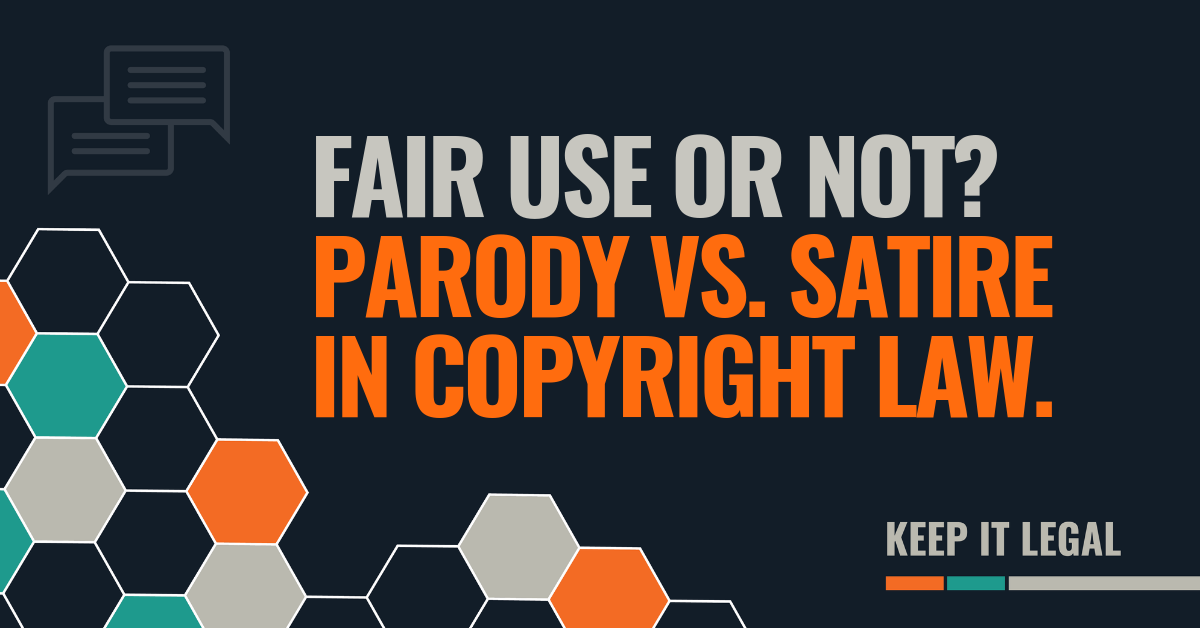Do you know the difference between parody and satire? While the terms are often confused with one another, U.S. copyright law treats parody and satire very differently. Understanding the difference between parody and satire can be crucial in determining whether something that uses all or part of another copyrighted work is protected under the doctrine of Fair Use.
What’s a Parody?
We commonly think of parodies in the context of a movie, song, play, etc. that is “poking fun” at something in our culture. Saturday Night Live skits and Spaceballs (Mel Brooks’ take on Star Wars) are a few common examples of parody. Legally, parodies are defined more broadly. In legal terms, a parody is a literary or artistic work that imitates the characteristic style of an author or a work for comic effect or ridicule. It is regarded as a criticism or comment on the original copyrighted work. In simple terms, it has to convey to the audience some type of message about the original work. This “message” fits can be understood to transform the original work (the work that’s being parodied) because that message is adding something new; it takes all or part of the original work and gives it a different purpose or character.
A parody must comment on something well-known enough for the audience to understand that it is a parody and not a completely original work in itself. A parody does not just have to make people laugh or make fun of the original work – instead, it could elicit anger, make the audience feel disgusted, or provoke warm and happy reactions. Any type of commentary will do.
OK, So What’s Satire?
Parody should not be confused with satire. A parody needs to mimic an original to make its point. Satire, on the other hand, may use an original copyrighted work to make a point about, or comment on, something other than the copyrighted work.
Songs by “Weird Al” Yankovic are a good example. While they are often referred to as “parodies,” they would more properly be classified as satire, because he tends to use a copyrighted song by an artist and changes the lyrics to make a joke about something else in society. For example, he used the tune of Don MacLean’s “American Pie” to compose a riff on Star Wars. That song wasn’t really commenting on or making fun of “American Pie”, it was commenting on and making fun of Star Wars.
One More Time
Let’s try to make the difference crystal clear:
Imitating something to comment on it is a parody.
Using a copyrighted work to comment on something else is satire.
How Does the Law Treat Parodies and Satires?
In Campbell v. Acuff-Rose Music, Inc., the Supreme Court ruled in favor of the rap group 2 Live Crew when they were sued by the owners of the copyright for Roy Orbison’s song “Oh, Pretty Woman.” 2 Live Crew had recorded a…colorful…interpretation of the song. The Court determined that this parody was protected under the Fair Use doctrine because the original work was transformed. As a result, parodies are entitled to strong First Amendment protection.
The use of someone else’s copyrighted work in the context of a satire, on the other hand, is less likely to be protected under the Fair Use doctrine. Why are parody and satire treated differently? According to the Supreme Court in the 2 Live Crew case cited above: “Parody needs to mimic an original to make its point, and so has some claim to use the creation of its victim’s (or collective victims’) imagination, whereas satire can stand on its own two feet and so requires justification for the very act of borrowing.”
Need help protecting your intellectual property? Get in touch.


